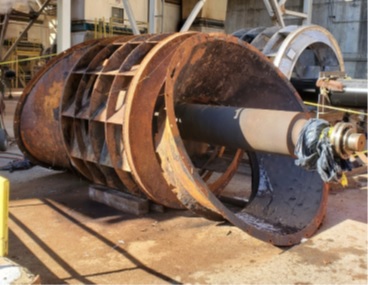
As fans operate within a flow system, wear and damage inevitably occurs. Debris builds up on internal components, causing efficiency and performance to decline. Challenging conditions like extreme temperatures, high humidity, and even certain sound environments reduce the fan’s performance, reliability, and efficiency over time. This leads to higher maintenance costs and increases operating costs due to excessive power usage.
Equipment that was improperly designed or inadequately maintained can wear or fail prematurely in its installed environment. Furthermore, as production demands evolve, your air blowing requirements may change, necessitating higher pressures and flows. All of these scenarios could indicate it is time to upgrade your equipment.

What does a upgrade involve
The answer can vary greatly depending on specific application requirements and the condition of existing equipment. Your application may only require some new components; or a full rebuild may be deemed necessary to achieve optimal levels of operation, output, and reliability.
A field technician will examine the operating conditions of your application and use insight from your current fan performance to offer design and material modifications or enhancements that will improve fan performance and extend its lifespan.
Categories of fan upgrades
1. Replacement
Replacement is the most common type of aftermarket project and involves replacing worn out equipment and damaged parts. A direct replacement project can range from simply replacing a few parts on your existing system to reverse-engineering parts for obsolete equipment from a manufacturer that no longer exists to replacing an entire system after a catastrophic failure.
2. Performance upgrades
Many users find that they need better performance out of their fans, beyond what a direct replacement of parts can provide.
Performance upgrades often involve engineering analysis to determine a solution to increase or decrease supply or pressure and increase fan efficiency to lower operating costs.
Depending on the application, the desired outcome may be achieved by modifying the existing rotor assembly, providing a new rotor assembly retrofitted to the existing fan housing, or providing a completely new system assembly.
3. Mechanical upgrades
Mechanical upgrades involve a design change and/or material upgrade to resolve fatigue or natural frequency issues within the equipment.
4. Corrosion or abrasion upgrades

To prevent corrosion, a change may be needed to the base material (for example, an alloy material better suited for the environment in which the equipment is operating). Other preventative measures include applying corrosion-resistant coatings like epoxy resins, polyurethane, baked phenolic coating, etc.
5.Addition of remote condition monitoring capabilities

Vibration, temperature, airflow, and pressure monitoring may be added to remotely observe system health and performance. Benefits include predictive maintenance, optimized power consumption in real-time, and increased total system reliability.
All industrial fans have a baseline level of vibration and temperature at which they normally run-up, run-down, and operate. These baselines vary by industry and are defined by ISO standards.
While some fluctuation in vibration and temperature is normal and isolated spikes may not be cause for concern, sustained changes to the baseline are often the first indication of a potential problem. Excess moisture and heavy, uneven dust loads on the fan impeller will gradually increase vibration, reducing efficiency and eventually leading to premature fan wear or unexpected failure. Remote monitoring proactively identifies the upward trend in vibration so that it can be investigated and resolved before major damage can occur.
To do this, vibration and temperature sensors are installed at the fan shaft and bearings to monitor for changes, and thresholds are set to trigger alerts if temperature or vibration exceeds the defined thresholds. Personnel can then follow up on the alert to quickly diagnose and resolve the issue before it escalates. This is called predictive maintenance.
While preventative maintenance plans rely on regular, scheduled maintenance, predictive maintenance uses real-time data from the equipment itself to reliably predict and prevent major problems that can lead to costly unplanned downtime. Predictive maintenance also eliminates human error in capturing or interpreting the data to reduce the risk of expensive mistakes.
With data captured via remote sensors, users can measure and improve Overall Equipment Effectiveness (OEE), which is the calculation of total availability, performance, and production quality.
With real-time airflow and pressure data, users can rapidly identify when a fan is running inefficiently and drawing more power than necessary. For example, if pressure exceeds a set threshold, the change triggers an alert to personnel to investigate why the fan is running inefficiently so they can resolve the problem causing excessive power consumption.
